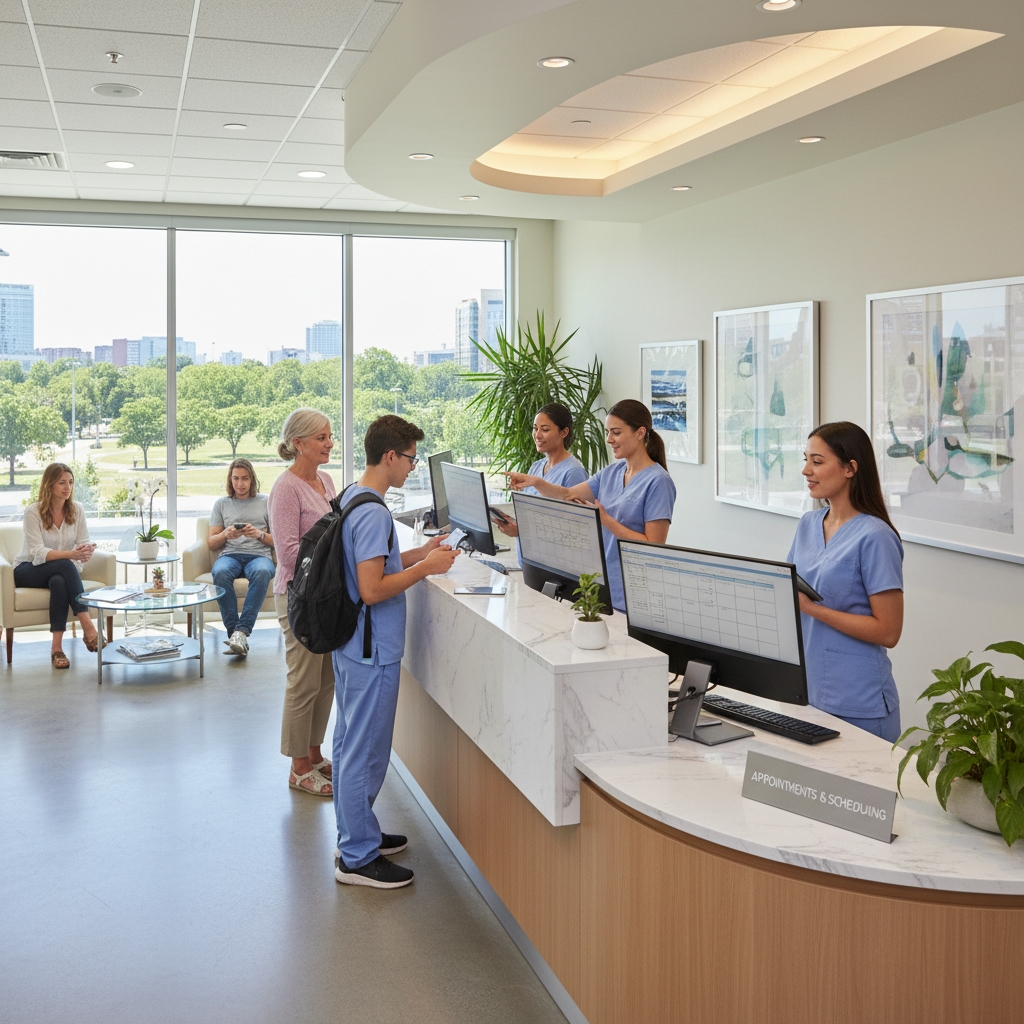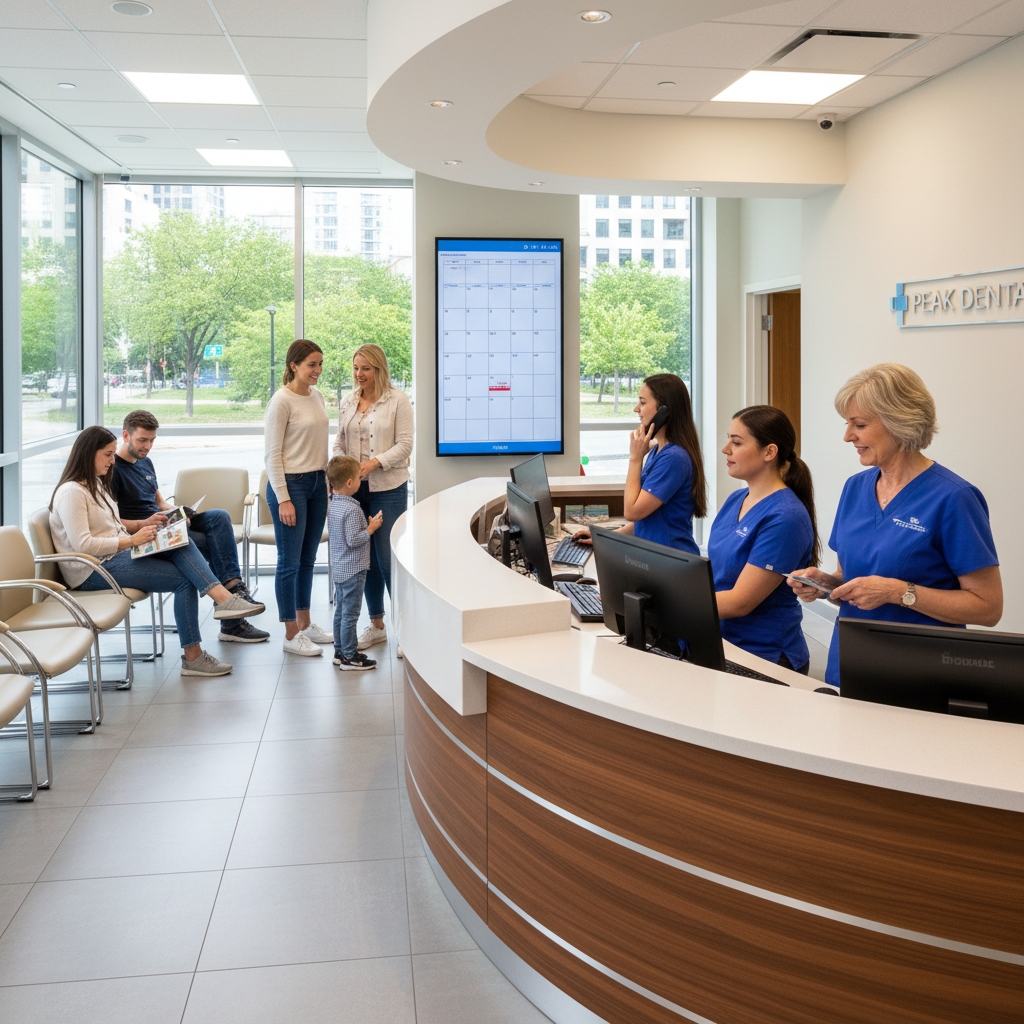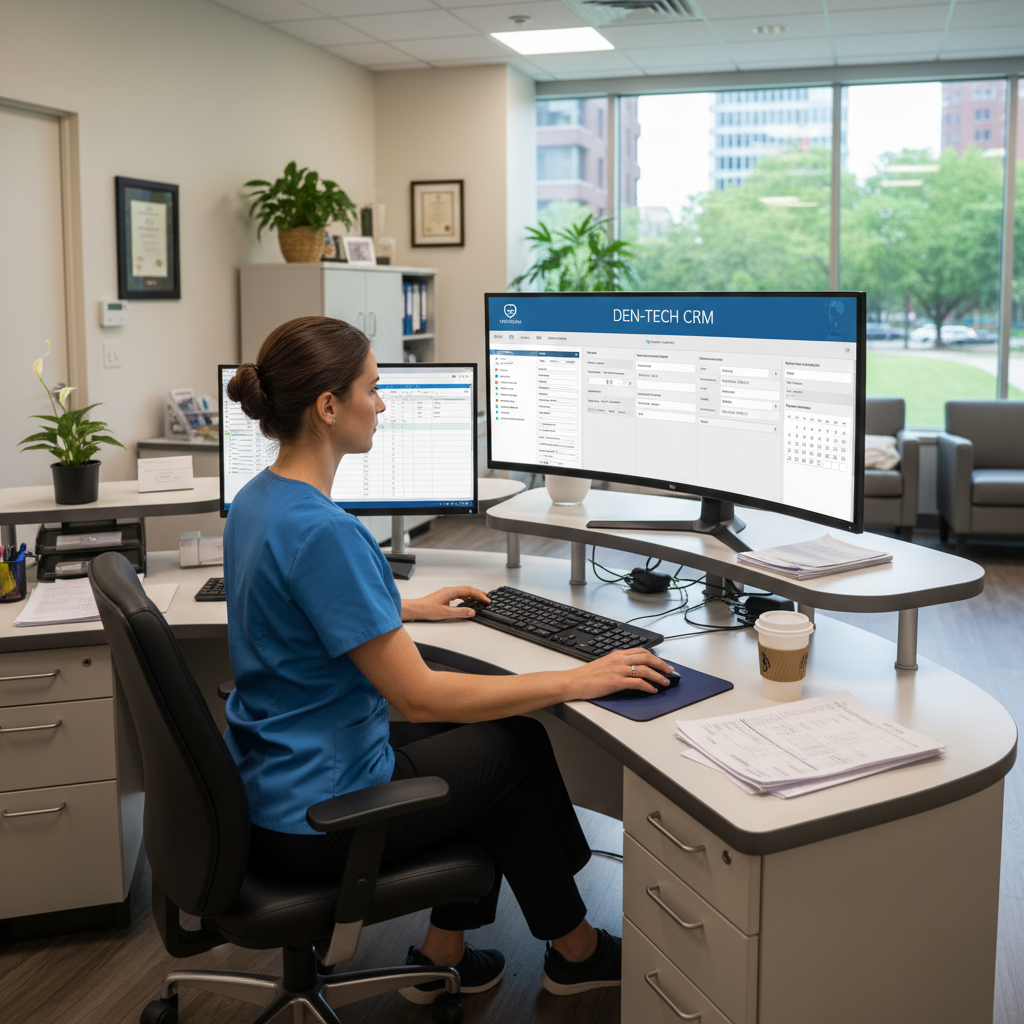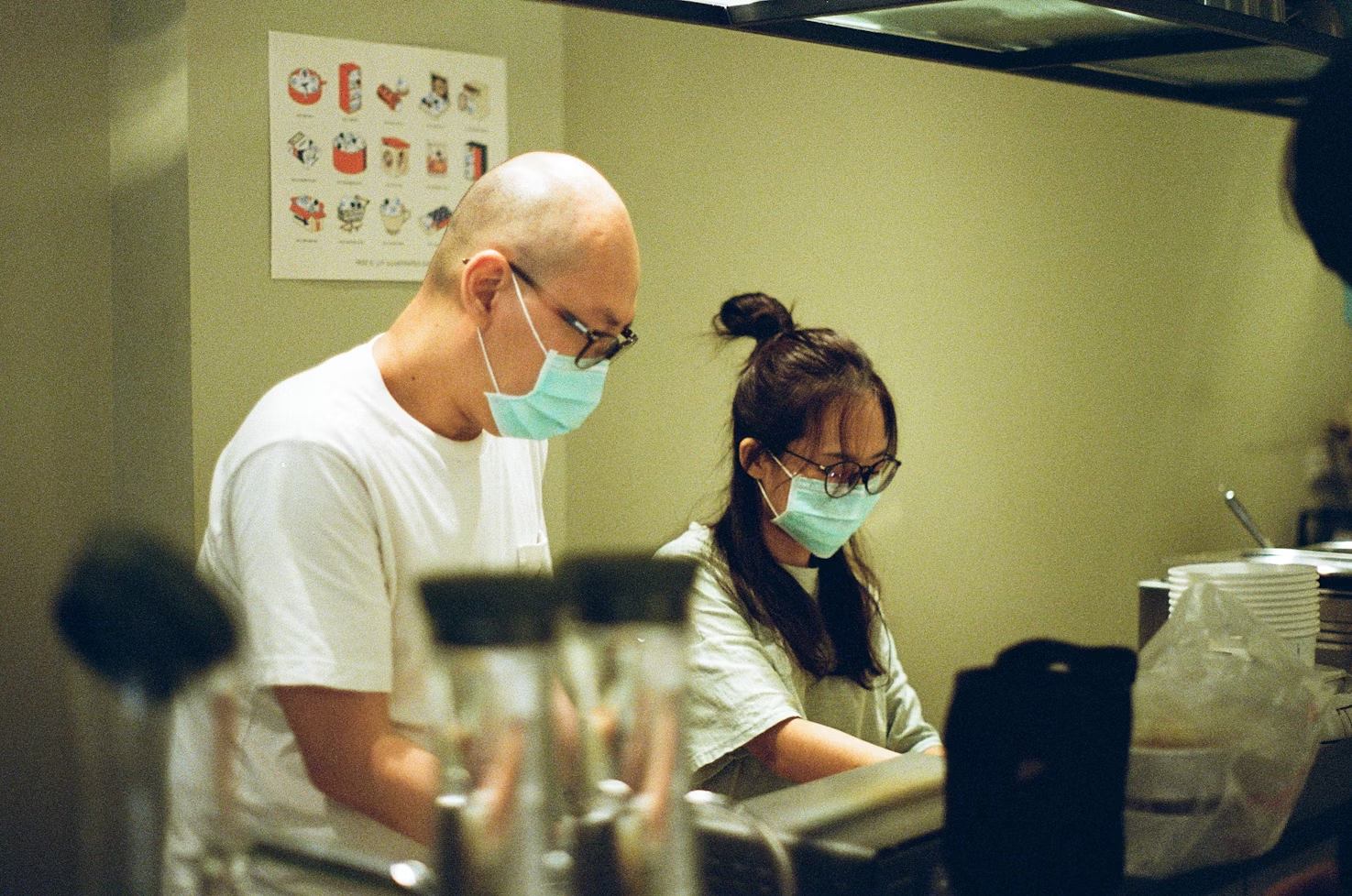












Blog Article


How To Never Miss a Dental Patient Call Again With AI Receptionists
Missing patient calls costs dental practices thousands of dollars in lost revenue every month. When patients can't reach your office, they often book appointments with competitors who answer their phones.
AI-powered phone assistants now handle patient calls 24/7, ensuring dental practices never miss appointment bookings, emergency calls, or patient inquiries again. These systems work like AI-powered virtual receptionists that answer calls instantly, schedule appointments, and provide basic information to patients outside normal business hours.
Modern dental practices and DSOs use automated phone systems to capture every potential patient interaction. The technology reduces staff workload while increasing patient satisfaction and practice revenue through consistent availability.
Key Takeaways
- AI phone assistants prevent revenue loss by capturing every patient call around the clock
- Automated systems reduce front desk staff burden while improving patient experience
- Multi-location dental groups benefit from centralized call management and detailed analytics
Missed Patient Calls Impact Dental Revenue
Dental practices miss 30-35% of incoming calls, resulting in over $100,000 in lost revenue annually per location. Understanding call conversion rates, peak-hour challenges, and revenue attribution helps practices identify exactly how missed calls affect their bottom line.
Call Answer Rate and Production Loss
The numbers tell a stark story about dental practice phone performance. Only 68% of new patient calls receive answers, and just 42% of answered calls convert to appointments.
This creates a devastating loss pattern. For every 100 new patient calls, practices lose 71 potential patients through unanswered calls and poor conversion rates.
The financial impact compounds quickly. Missing 10 new patients monthly at an average case value of $850 equals $8,500 in lost monthly revenue.
Annual losses reach $102,000 from missed new patient opportunities alone. Patient lifetime value makes this worse since the average patient stays 7-10 years with their dental practice.
Industry data shows practices miss one new patient daily based on typical call volumes and answer rates. Over 240 business days annually, this pattern creates substantial revenue gaps for dental practices and DSOs.
Peak and After-Hours Missed Calls
Peak calling periods create the highest risk for missed patient communication. Most dental emergencies and appointment requests occur outside standard business hours when front desk staff are unavailable.
Morning hours between 8-10 AM generate the heaviest call volumes. Lunch periods and end-of-day rushes also overwhelm phone systems.
Only 14% of new patients leave voicemails when calls go unanswered. The remaining 86% likely contact competing practices that answer their phones promptly.
Weekend and evening calls represent emergency situations or urgent scheduling needs. These high-value interactions often convert to same-day appointments or extensive treatment plans.
Practices operating without 24/7 phone coverage lose these premium opportunities to competitors with better availability. DSOs particularly suffer from this pattern across multiple locations with varying peak times.
Revenue Attribution Metrics
Tracking specific revenue losses from missed calls requires detailed call analytics and conversion data. Practices need baseline metrics to understand their actual performance gaps.
Average new patient revenue ranges from $300-$1,200 depending on treatment complexity and practice specialty. Emergency calls typically convert at higher rates and generate immediate revenue.
Conversion rate improvements from 35% to 65% demonstrate the revenue potential when practices address their phone handling problems effectively. This represents nearly doubling appointment bookings from existing call volume.
Call tracking systems reveal patterns in missed opportunities by time, day, and call type. Practices can identify their specific weak points and calculate exact revenue losses.
Monthly missed call reports help DSOs compare performance across locations and identify best practices for phone management training and technology implementation.
Manual Front Desk Challenges in Dental Clinics
Traditional front desk operations create significant bottlenecks that cost dental practices thousands in lost revenue and patient satisfaction. Staff overload from high call volumes leads to missed appointments, while coordination across multiple locations becomes increasingly complex without automated systems.
Staff Overload and Burnout
Front desk staff handle an overwhelming volume of daily tasks that extend far beyond answering phones. They manage appointment scheduling, insurance verification, payment processing, and patient inquiries simultaneously.
Daily Task Load:
- 50-100+ phone calls per day
- Real-time appointment scheduling conflicts
- Insurance pre-authorization requests
- Patient follow-up calls
- Emergency appointment coordination
The constant juggling of multiple systems creates stress and increases error rates. Staff members frequently work through lunch breaks to catch up on administrative tasks. High turnover rates in dental front desk positions reflect this unsustainable workload.
Many dental practices struggle with front desk communication issues including language barriers and poor coordination between departments. This leads to frustrated employees who feel overwhelmed by competing priorities.
Call center operations become particularly challenging during peak hours when appointment requests surge. Staff cannot provide adequate attention to each caller, resulting in shorter conversations and missed opportunities to address patient concerns.
Follow-Up Gaps and No-Shows
Manual follow-up processes create significant gaps in patient communication that directly impact practice revenue. Staff often forget to call patients about treatment plans or upcoming appointments due to competing priorities.
Common Follow-Up Failures:
- Missed treatment plan discussions
- Late appointment confirmations
- Inadequate insurance updates
- Poor recall system management
No-show rates increase when practices rely on manual reminder systems. Staff may call patients at inconvenient times or fail to reach them entirely. This results in empty appointment slots that could have been filled with proper advance notice.
Treatment acceptance rates suffer when follow-up conversations happen days or weeks after the initial consultation. Patients lose interest or forget important details about recommended procedures. The delay between diagnosis and treatment scheduling creates opportunities for patients to seek care elsewhere.
Insurance verification delays compound these issues when staff cannot complete pre-authorizations before scheduled appointments. Patients arrive unprepared for costs or discover coverage limitations at check-in.
Multilocation Coordination Barriers
DSOs and multi-practice owners face unique challenges when coordinating front desk operations across different locations. Each office typically operates independently with separate phone systems and scheduling software.
Coordination Problems:
- Inconsistent patient communication standards
- Duplicate patient records across locations
- Difficulty transferring appointments between offices
- Varied staff training levels
Patient transfers between locations require multiple phone calls and manual data entry. Staff at different offices may provide conflicting information about procedures, costs, or availability. This creates confusion and erodes patient confidence in the organization.
Emergency scheduling becomes particularly difficult when one location is fully booked but nearby offices have availability. Without centralized systems, staff cannot easily redirect patients to alternative locations. Revenue opportunities are lost when practices cannot accommodate urgent patient needs across their network.
Training consistency suffers when each location develops its own front desk procedures. New staff members receive different instruction depending on their assigned office, leading to uneven patient experiences across the organization.
AI-Powered Assistance for Dental Practices
Modern dental practices use AI technology to handle phone calls automatically and manage patient appointments without human staff. These systems work around the clock to answer questions, book appointments, and update schedules in real time.
Automated Receptionist Functions
AI-powered phone assistants handle incoming calls 24 hours a day, seven days a week. They answer basic patient questions about office hours, services, and insurance acceptance. The system can transfer complex calls to human staff when needed.
These virtual receptionists speak with professional dental language. They collect patient information like name, phone number, and reason for calling. Key functions include:
- Answering frequently asked questions
- Collecting new patient information
- Handling insurance verification requests
- Providing directions to the office
The AI system learns from each conversation. It gets better at handling specific questions that patients ask most often. Staff can review call logs to see what patients need most.
Context-Aware Scheduling Workflows
AI scheduling systems understand different types of dental appointments and their time requirements. A cleaning appointment needs 60 minutes while a consultation might only need 30 minutes. The system knows these differences automatically.
The technology checks dentist availability and patient preferences before suggesting appointment times. It considers factors like patient history, treatment type, and staff schedules. This prevents double-booking and scheduling conflicts.
Smart workflows also handle appointment changes. When a patient cancels, the system can offer that time slot to patients on a waiting list. It sends automatic reminders through text or email before appointments.
Appointment Booking Optimization
AI answering services for dental practices optimize scheduling by filling gaps in the daily schedule. The system identifies open slots and matches them with patient needs and preferences.
Calendar integration connects the AI system with existing practice management software. Appointments booked through AI appear instantly in the main scheduling system. This prevents scheduling errors and keeps all staff updated.
The optimization process considers travel time between appointments and procedure setup requirements. It also tracks no-show patterns and adjusts scheduling strategies accordingly. Some systems can overbook slightly based on historical data to maximize chair time utilization.
24/7 Virtual Receptionist for Dentists and DSOs
Modern dental practices lose potential patients when calls go unanswered, but AI-powered virtual receptionists eliminate this problem by detecting missed calls, responding with personalized messages, and connecting directly to practice management systems. These systems work around the clock to capture every patient interaction.
Unanswered Calls Detection
AI-powered dental receptionists monitor incoming calls in real-time and identify when patients reach voicemail or disconnect due to long wait times. The system tracks call patterns and immediately flags missed opportunities.
Key Detection Features:
- Real-time call monitoring
- Abandoned call tracking
- Peak hour analysis
- Patient callback identification
When a call goes unanswered, the system logs patient information and call details automatically. This data helps practices understand their busiest periods and staffing needs.
The technology differentiates between emergency calls and routine inquiries. Emergency calls trigger immediate alerts to designated staff members, while routine calls enter the automated response queue.
Practices typically see 88% of voicemail calls never returned by patients. Detection systems prevent this loss by catching calls before they reach voicemail.
Human-Like Auto-Texting
Virtual receptionists send personalized text messages to patients within seconds of missed calls. These messages sound natural and include specific practice information like office hours and services.
Text Message Components:
- Practice name and branding
- Appointment scheduling links
- Emergency contact information
- Callback time estimates
The system customizes messages based on call timing and patient history. New patients receive welcome messages with practice information, while existing patients get direct scheduling options.
Messages include two-way communication capabilities. Patients can respond with questions or requests, and the AI handles common inquiries about hours, services, and insurance acceptance.
Response rates for automated patient communications average 65% higher than traditional callback methods. Patients appreciate immediate acknowledgment of their calls.
Seamless PMS Integration
Virtual receptionist systems connect directly to existing practice management software without disrupting current workflows. Integration typically takes 24-48 hours and requires minimal staff training.
Integration Capabilities:
- Appointment scheduling - Direct calendar access
- Patient records - Automatic updates
- Insurance verification - Real-time checks
- Treatment history - Complete access
The system pulls patient information from PMS databases to personalize interactions. When existing patients call, the AI accesses their treatment history and upcoming appointments.
New appointment requests sync automatically with practice calendars. Staff members see new bookings immediately without manual data entry.
Most major PMS platforms support API integration, including Dentrix, Eaglesoft, and Open Dental. The virtual receptionist updates patient records with call logs and scheduling changes in real-time.
DSOs benefit from centralized reporting across multiple locations. Practice managers view call statistics, booking rates, and patient satisfaction scores from a single dashboard.
Analytics and Performance Insights
AI-powered call analytics reveal exactly when and why dental practices miss patient calls. These systems track call patterns throughout the day and measure how missed opportunities affect practice revenue.
Missed-Call Heatmaps
Visual heatmaps show the exact times when most patient calls go unanswered. These maps typically reveal peak missed-call periods between 9-11 AM and 2-4 PM when staff handle patient check-ins.
The data identifies which days of the week generate the highest volume of unanswered calls. Monday mornings and Friday afternoons often show the darkest spots on these maps.
Key metrics tracked include:
- Hourly missed call volumes
- Day-of-week patterns
- Call abandonment rates
- Hold time distributions
Practices can adjust staffing schedules based on these patterns. Adding an extra receptionist during peak missed-call periods often reduces lost appointments by 40-60%.
The heatmaps also show seasonal trends. Many dental practices see increased missed calls during back-to-school periods and before major holidays when appointment demand spikes.
Revenue Attribution Analysis
Each missed call represents lost revenue that practices can now measure precisely. AI-driven analytics uncover patterns in patient behavior and calculate the financial impact of unanswered phones.
The average missed call in dentistry costs between $200-500 in lost treatment revenue. Emergency calls carry higher values, often representing $800-1,200 in immediate treatment needs.
Revenue tracking includes:
- Treatment value per missed call type
- New patient acquisition costs
- Follow-up appointment conversions
- Emergency vs routine call values
Practices can track which missed calls result in patients scheduling elsewhere. Studies show that 78% of dental patients who reach voicemail will call a competitor within 24 hours.
The analysis breaks down revenue loss by call type, time of day, and staff member. This data helps practices prioritize which missed calls require immediate follow-up attention.
Staff Follow-Up Tracking
Analytics systems monitor how quickly staff return missed calls and measure conversion rates for different response times. Calls returned within 15 minutes convert to appointments 85% more often than those returned after two hours.
The tracking shows which team members achieve the highest callback conversion rates. Top performers often use specific language patterns and follow proven callback scripts.
Performance metrics include:
- Callback response times
- Conversion rates by staff member
- Follow-up success rates
- Patient satisfaction scores
Practices can identify training opportunities when certain staff members consistently show lower callback conversion rates. The data reveals which approaches work best for different call types.
The system tracks multi-touch follow-up sequences. Missed calls that receive both phone and text follow-ups show 45% higher appointment booking rates than single-method outreach.
Custom Solutions for Multi-Location Dental Groups
Multi-location dental groups require specialized AI systems that can handle complex workflows across different offices while maintaining consistent patient service standards. These solutions must integrate seamlessly with existing practice management systems and scale efficiently as organizations grow.
White-Label and Integrations
White-label AI solutions allow dental service organizations to maintain their brand identity across all patient touchpoints. The AI assistant uses the practice's name, follows established protocols, and integrates directly with popular practice management software like Dentrix, Eaglesoft, and Open Dental.
Integration capabilities extend beyond basic scheduling. Advanced systems sync patient records, insurance information, and treatment histories across all locations in real-time. This eliminates duplicate data entry and ensures consistent patient experiences regardless of which office they contact.
Key Integration Features:
- Real-time synchronization with practice management software
- Custom scripting that matches existing phone protocols
- Automated patient record updates across all locations
- Insurance verification and pre-authorization handling
Even small practices benefit from these integrations when they expand to multiple locations. The system grows with the organization without requiring complete workflow overhauls.
Multi-Location Rollouts
Successful AI implementation across multiple locations requires a phased rollout approach. Organizations typically start with their highest-volume location to test workflows and refine processes before expanding to other offices.
The rollout process begins with detailed workflow mapping for each location. Different offices may have unique scheduling patterns, staff responsibilities, or patient demographics that require customization. AI-powered solutions for dental offices can accommodate these variations while maintaining operational consistency.
Rollout Timeline:
- Week 1-2: Primary location setup and testing
- Week 3-4: Staff training and workflow refinement
- Week 5-6: Secondary location deployment
- Week 7-8: Full system optimization across all locations
Training staff across multiple locations presents unique challenges. Remote training sessions, standardized documentation, and ongoing support ensure consistent adoption rates. Each location designates a point person who becomes the local expert and handles day-to-day troubleshooting.
Centralized Patient Communication
Centralized communication systems allow dental groups to manage all patient interactions from a single dashboard. This approach provides unprecedented visibility into call volumes, appointment patterns, and patient satisfaction across the entire organization.
The centralized system automatically routes calls based on location, appointment type, or patient preferences. Emergency calls receive immediate attention, while routine scheduling requests are handled efficiently through automated workflows. Administrative staff can monitor multiple locations simultaneously and intervene when necessary.
Dashboard Features:
- Real-time call volume monitoring across all locations
- Automated appointment scheduling and confirmations
- Patient communication history tracking
- Performance analytics and reporting tools
Dental answering services complement centralized AI systems by providing human backup for complex situations. This hybrid approach ensures no patient call goes unanswered while maintaining cost efficiency.
The system maintains separate patient databases for each location while allowing cross-location appointment scheduling when appropriate. Patients can easily transfer between offices or schedule services at their preferred location without repeating their information.
Boost Patient Engagement with Resonate's AI Platform
Resonate AI transforms missed calls into appointment bookings while delivering empathetic communication that maintains the personal touch patients expect. The platform recovers lost production and demonstrates measurable ROI through automated texting and comprehensive patient interaction management.
Empathetic AI Texting and Visit Details
Resonate AI sends personalized text messages to missed callers within seconds of their call. The system crafts messages that sound natural and caring rather than robotic or generic.
The platform gathers essential patient information through conversational texting. Patients can share their preferred appointment times, insurance details, and treatment concerns without waiting on hold.
Key messaging features include:
- Appointment scheduling directly through text
- Insurance verification requests
- Treatment reminders and follow-ups
- Emergency contact protocols
The AI adapts its communication style based on the patient's responses. New patients receive welcome messages with office policies, while existing patients get personalized updates about their treatment plans.
This approach significantly improves patient experience by providing immediate responses. Patients feel valued when their calls receive instant attention, even during busy office hours.
Lost Production Recovery
Dental practices lose substantial revenue when calls go unanswered. AI-driven patient engagement tools help capture these missed opportunities by converting abandoned calls into scheduled appointments.
The platform tracks every missed call and initiates contact within minutes. This rapid response prevents patients from calling competing practices.
Revenue recovery metrics include:
- Average appointment value: $350-500 per new patient
- Conversion rate: 15-25% of missed calls become appointments
- Monthly recovery: $8,000-15,000 for typical practices
The system prioritizes high-value treatments like implants or cosmetic procedures. When patients mention these services, the AI schedules priority consultations with appropriate providers.
Patient retention improves as the platform maintains consistent communication. Existing patients receive proactive outreach for routine cleanings and treatment plan follow-ups.
Case Study Metrics for Dental Practices
Dental practices using Resonate AI report capturing 174+ new patients monthly with documented 60x return on investment. These results demonstrate the platform's effectiveness across various practice sizes.
Performance data shows:
Practice SizeNew Patients/MonthROI MultipleRevenue IncreaseSingle Location174+60x$87,000+Small DSO (3-5)400+45x$200,000+Large DSO (10+)1,200+40x$600,000+
The platform addresses the critical statistic that 78% of patients book with the first practice that responds. By ensuring immediate response to every call, practices capture more market share.
Patient satisfaction scores increase by an average of 23% after implementation. Patients appreciate the quick responses and convenient scheduling options.
Practices report reduced staff stress as the AI handles routine scheduling calls. This allows front desk teams to focus on in-person patient care and complex appointment coordination.
The system provides detailed analytics on call patterns, peak hours, and conversion rates. DSOs use this data to optimize staffing and identify high-performing locations.
Frequently Asked Questions
AI-powered phone systems help dental practices capture more appointments and reduce missed calls through 24/7 availability and automated scheduling features. These systems integrate with existing practice management software to streamline patient communications.
What technology can dentists use to ensure that patient calls are always answered?
Dental practices can implement AI-powered phone assistants that handle patient inquiries 24/7. These systems answer calls automatically and can schedule appointments even during off-hours.
Voice recognition technology allows these AI systems to understand patient requests. They can handle basic questions about office hours, insurance, and appointment availability.
Call routing features direct complex calls to the appropriate staff members. The AI system handles routine inquiries while forwarding urgent dental emergencies to on-call dentists.
Integration with existing phone systems requires minimal setup. Most AI phone concierge services provide high return on investment by converting more calls into scheduled appointments.
How can AI assistance improve patient satisfaction in dental practices?
AI systems eliminate busy signals and long hold times for patients. Callers receive immediate responses to basic questions about appointments, procedures, and office policies.
Appointment scheduling becomes available around the clock. Patients can book, reschedule, or cancel appointments at their convenience without waiting for office hours.
Consistent service quality ensures every patient receives the same level of professional assistance. AI systems never have bad days or forget important details about practice policies.
Reduced wait times lead to higher patient satisfaction scores. The technology handles multiple calls simultaneously without creating bottlenecks in the phone system.
In what ways can AI-powered tools integrate with existing office systems for handling patient communications?
Modern AI phone systems connect directly with practice management software. This integration allows real-time appointment scheduling without double-booking conflicts.
Electronic health records sync with AI platforms to access patient information during calls. The system can reference previous appointments and treatment history when needed.
Calendar integration ensures accurate scheduling across multiple providers. The AI system checks availability in real-time before confirming patient appointments.
Billing system connections allow the AI to answer basic insurance and payment questions. Patients receive immediate information about coverage and outstanding balances.
What are the benefits of using artificial intelligence for call management in dental service organizations?
DSOs can standardize patient communication across multiple locations. AI systems ensure consistent messaging and service quality at every practice in the organization.
Cost reduction occurs through decreased staffing needs for phone management. Administrative costs can be reduced by up to 70% when implementing AI phone systems.
Centralized reporting provides insights into call patterns and patient needs. DSOs can analyze data from all locations to identify trends and improvement opportunities.
Scalability becomes easier as
Similar Articles
Ready to Get Started
Have Questions?
We're Here to Help
Connect with our team for personalized guidance
No setup fees, cancel anytime.
.avif)

.svg)
.svg)


